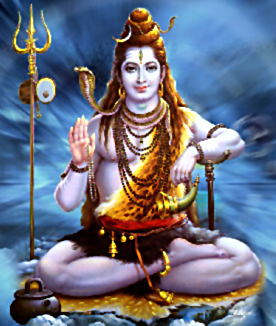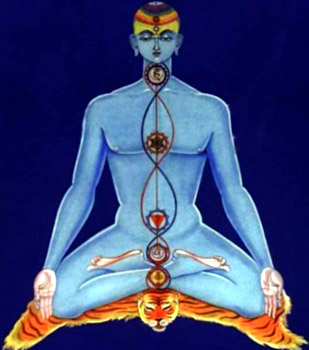 Kauladharma, or the belief of the Kaula School of Saktas is held by Tantric practices to be the best of all religions and is spoken of by them in the highest terms. The adoration of the Kula saint is praised as supremely meritorious. The most comprehensive idea about the Kula school of Saktas is obtained from a closer analysis of some of the works of Kauladharma. These are briefly discussed below.
Kauladharma, or the belief of the Kaula School of Saktas is held by Tantric practices to be the best of all religions and is spoken of by them in the highest terms. The adoration of the Kula saint is praised as supremely meritorious. The most comprehensive idea about the Kula school of Saktas is obtained from a closer analysis of some of the works of Kauladharma. These are briefly discussed below.
One of the principal works of the Kaulas, i.e., the most advanced of the Saktas, is the Kularnava Tantra. This work teaches that there are six forms of life which are but an introduction to the Kulacara, and that release from suffering, and the highest salvation can only be attained through the Kulacara or Kula-Dharma. When the Devi asks Lord Shiva how salvation is to be attained, Shiva replies that only through the knowledge of the Unity can a person be released from suffering. All living creatures are surrounded by Maya. In order to become a Kaula a man should avoid all external things and strive only for true knowledge. Ritual and asceticism are of value only as long as a man has not yet recognised the truth. The Kula Dharma is Yoga (meditation) as well as Bhoga (enjoyment), but only for the man who has purified his mind and has control over his senses. The book contains doctrines on the true knowledge of Yoga and of the Brahman, as well as the most minute details concerning the preparation of twelve kinds of intoxicating drinks and everything connected with the "five essentials," which bestow Bhukti (enjoyment) and Mukti (salvation) at the same time.
 As regards food habits, drink is given a very important role in the Kaula School. It is said that the Brahmin should drink at all times, the warrior at the beginning of the battle, the Vaishya when purchasing cows, the Sudras when performing the funeral sacrifices. In Chapter VII, the necessity of drink in the cult of Shakti is again emphasized. It is true that one should only drink in moderation, but this moderation is reckoned very liberally- as long as the eye, the understanding, speech and the body do not become unsteady, a man may continue drinking, but drink taken in excess of this is the drinking of a brute beast. Though it is true that only the initiated are allowed to drink, it is to them that the oft-quoted maxim is addressed: " He is to drink, drink and drink again, till he falls to the ground, and when he has arisen, he is to drink yet again- then there will be no rebirth".
As regards food habits, drink is given a very important role in the Kaula School. It is said that the Brahmin should drink at all times, the warrior at the beginning of the battle, the Vaishya when purchasing cows, the Sudras when performing the funeral sacrifices. In Chapter VII, the necessity of drink in the cult of Shakti is again emphasized. It is true that one should only drink in moderation, but this moderation is reckoned very liberally- as long as the eye, the understanding, speech and the body do not become unsteady, a man may continue drinking, but drink taken in excess of this is the drinking of a brute beast. Though it is true that only the initiated are allowed to drink, it is to them that the oft-quoted maxim is addressed: " He is to drink, drink and drink again, till he falls to the ground, and when he has arisen, he is to drink yet again- then there will be no rebirth".
On the other hand, when these and similar rules have been formulated, it is said that true drinking is the union of Kundalini Shakti with Cichandra (moon of thought), others being merely imbibers of intoxicants. Flesh eating too is an important part of the Kauladharma. The true flesh eater is said to be the one who merges his thought in the highest Being, and a true fish eater is he who curbs his senses and unites them with the Atman. It is said that others merely kill animals. The true Maithuna is the union of the highest Sakti or Kundalini with the Atman; others are merely slaves to women." This comes at the close of Chapter V.
Another oft-quoted work of the Kaula School of the Saktas is the "Head jewel of the Kula," (Kulacudamani) an example of a Nigama. In this work, the Devi proclaims the doctrine and Shiva listens in the character of a pupil. In reality Shiva and Devi are one. Everything whatever exists in the world, consists of Shiva and Sakti. The work begins with an enumeration of the Kulasundaris or Devis, and then describes the worship of the Saktis with Yantras as well as meditations on the unity of the Great Mother. Instructions are given for the worship not only of one`s own wife but also for that of an outside `Sakti.` He who would be admitted to the Chakra rites, must first have walked in the path of the love of God (Bhaktimarga) according to Vaishnavism, and he must be good and patient to others. The last three chapters deal solely with magic.
Thus a brief idea of the beliefs and principles of Kauladharma is obtained from the foregoing discussion.









